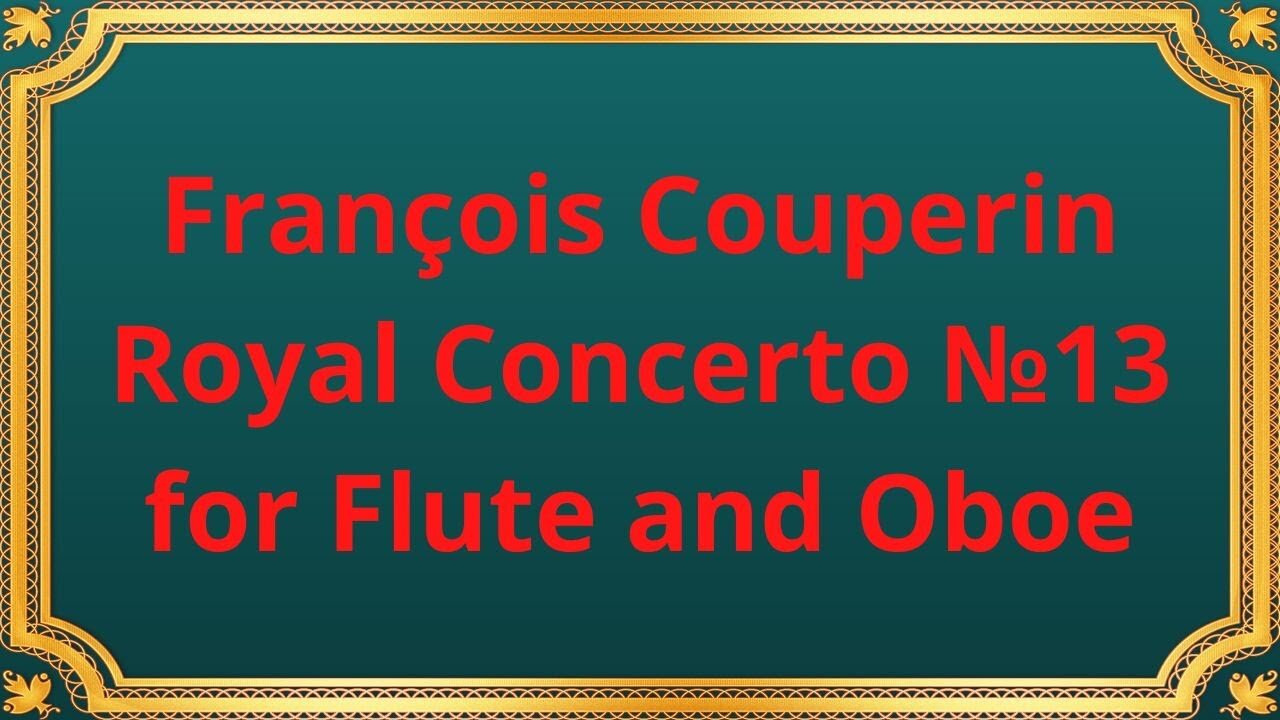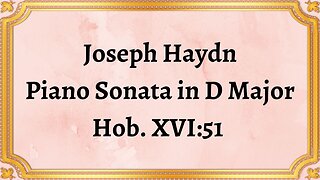Premium Only Content

François Couperin Royal Concerto №13 for Flute and Oboe
#FrançoisCouperin #ClassicalMusic #RoyalConcertoNo13 #Flute #Oboe #MusicalComposition #BaroqueMusic
THE PARIS BAROQUE TOGETHER
J. P. RAMPAL, Flute; P. PIERLOT, Oboe; R. GENDRE, Violin;
P. HONGNE, Bassoon; R. VEYRON - LACROIX, Harpsichord
François Couperin, a prominent figure in French Baroque music, left an indelible mark on the world of classical composition. Among his vast body of work, the Royal Concerto No. 13 for Flute and Oboe stands as a testament to his musical brilliance.
François Couperin, known as "Couperin le Grand," was a talented composer and musician who flourished during the late 17th and early 18th centuries. He served as the court composer for King Louis XIV of France, where he composed numerous works, including the Royal Concerto No. 13. This piece, written in the year 1722, showcases Couperin's mastery of the French musical style prevalent during the Baroque era.
Couperin's Royal Concerto No. 13 is a meticulously crafted composition that exemplifies the elegance and refinement of French Baroque music. The concerto, scored for flute and oboe, is structured in three movements: a lively and spirited Allegro, a lyrical and expressive Adagio, and a vibrant and energetic Gavotta. Each movement showcases the virtuosity and musical dialogue between the flute and oboe, creating a harmonious interplay of melodic lines and intricate ornamentation.
The Allegro movement, marked by its joyful and lively tempo, features intricate melodic passages and lively exchanges between the two solo instruments. Couperin skillfully weaves together contrasting musical themes, showcasing his ability to create a rich tapestry of sound. The Adagio movement, in contrast, slows the pace and evokes a sense of introspection and emotional depth. The flute and oboe engage in a delicate musical conversation, their intertwining melodies creating a serene and contemplative atmosphere. The final Gavotta movement brings forth a vivacious and spirited dance, characterized by its rhythmic drive and lively tempo. The flute and oboe engage in playful exchanges, demonstrating their technical prowess and musical synergy.
François Couperin's Royal Concerto No. 13 for Flute and Oboe serves as a testament to his remarkable talent as a composer. Its intricate melodies, masterful interplay, and elegant ornamentation showcase the epitome of French Baroque music. This composition not only highlights Couperin's skill in crafting engaging and expressive music but also captures the essence of the French courtly style prevalent during his time.
The enduring significance of this concerto lies in its ability to captivate listeners across generations. Its timeless melodies and harmonies continue to resonate with audiences, showcasing the enduring power of classical music. Moreover, the Royal Concerto No. 13 stands as a testament to Couperin's legacy, solidifying his position as one of the most influential composers of the Baroque era.
Conclusion:
François Couperin's Royal Concerto No. 13 for Flute and Oboe stands as a testament to his musical genius and the richness of French Baroque music. Through its intricate melodies, masterful interplay, and timeless beauty, this composition continues to captivate listeners and showcase the enduring power of classical music. As we delve into the harmonious world of this concerto, we are reminded of the remarkable talent and lasting legacy of François Couperin, whose music continues to inspire and enchant audiences around the world.
You have the opportunity to support the channel:
https://destream.net/live/RadSiarAl/donate
https://www.buymeacoffee.com/6355radsiaral
-
 6:07
6:07
Classical music_Music Inspiration
1 month agoJoseph Haydn Piano Sonata in D Major, Hob. XVI:51
861 -
 LIVE
LIVE
Kim Iversen
1 hour agoTrump to Zelenskyy: 'You're Gambling with World War III'
1,748 watching -
 LIVE
LIVE
Dr Disrespect
9 hours ago🔴LIVE - DR DISRESPECT - PGA TOUR 2K25 LAUNCH DAY
3,385 watching -
 55:28
55:28
Glenn Greenwald
3 hours agoGlenn Reacts to Trump-Zelensky Exchange and Takes Q&A from our Members | SYSTEM UPDATE #415
22.5K57 -
 DVR
DVR
Nerdrotic
5 hours ago $14.94 earnedMarvel PANIC MODE! Kathleen Kennedy GONE?! Hollywood DEI Dead | Friday Night Tights 342 Nick Freitas
55.7K15 -
 LIVE
LIVE
IsaacButterfield
4 hours agoFree Speech Is Dead | Did Trump Go Too Far? | Sexist Job
110 watching -
 1:02:59
1:02:59
Sarah Westall
7 hours agoEpstein Files, Dueling Cabal Factions and Gold from Ancient Civilizations w/ Dave Hodges
9.93K5 -
 LIVE
LIVE
CatfishedOnline
5 hours ago23-Yr-Old Drove 2,650 Miles to Meet Online Girlfriend in Romance Scam
119 watching -
 LIVE
LIVE
Bare Knuckle Fighting Championship
2 days agoCountdown to BKFC FIGHT NIGHT ALBUQUERQUE & FREE LIVE FIGHTS!
213 watching -
 1:46:26
1:46:26
Vigilant News Network
6 hours agoDiddy’s Epstein Moment: Is the Fix Already In? | The Daily Dose
61K5